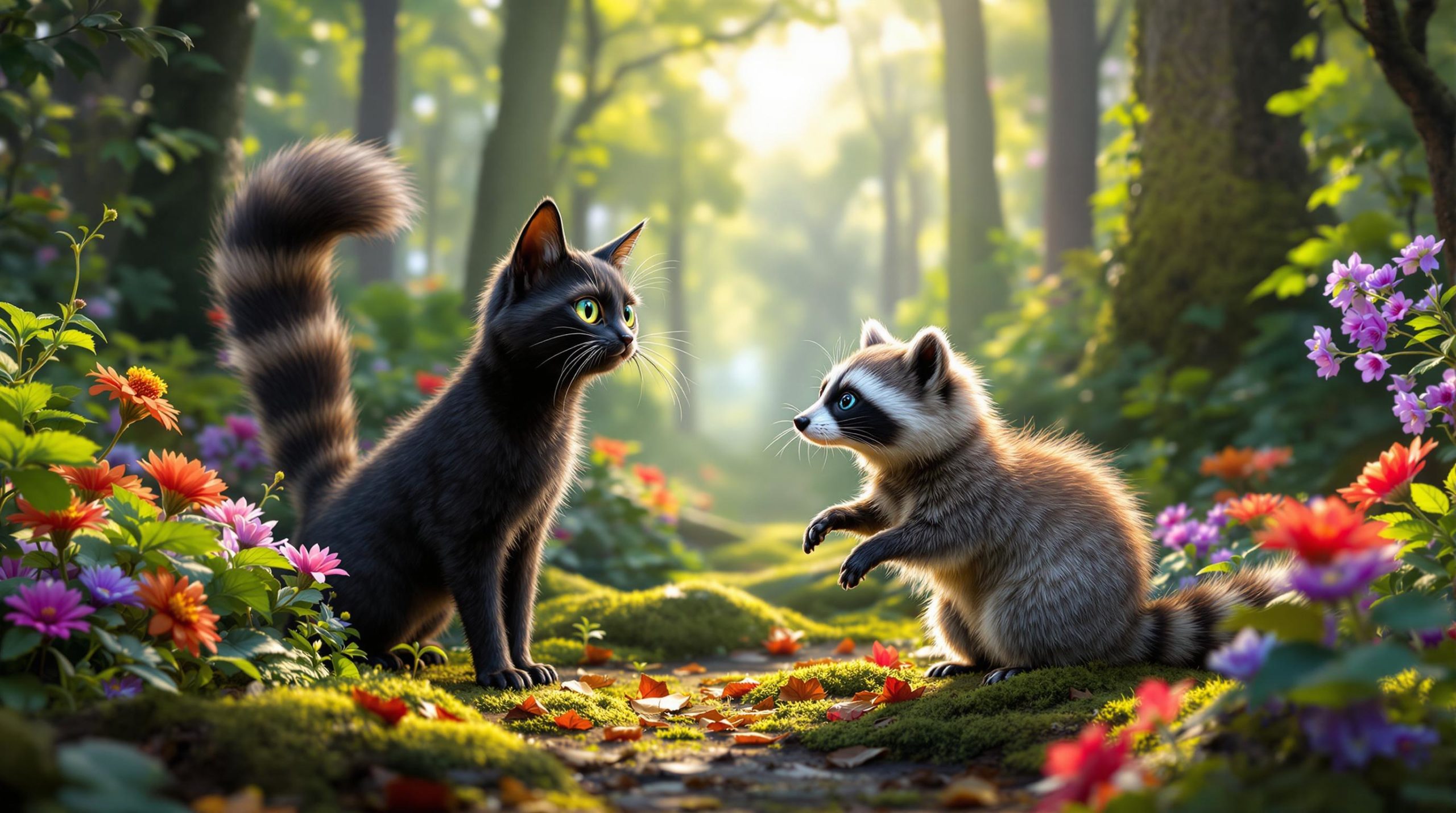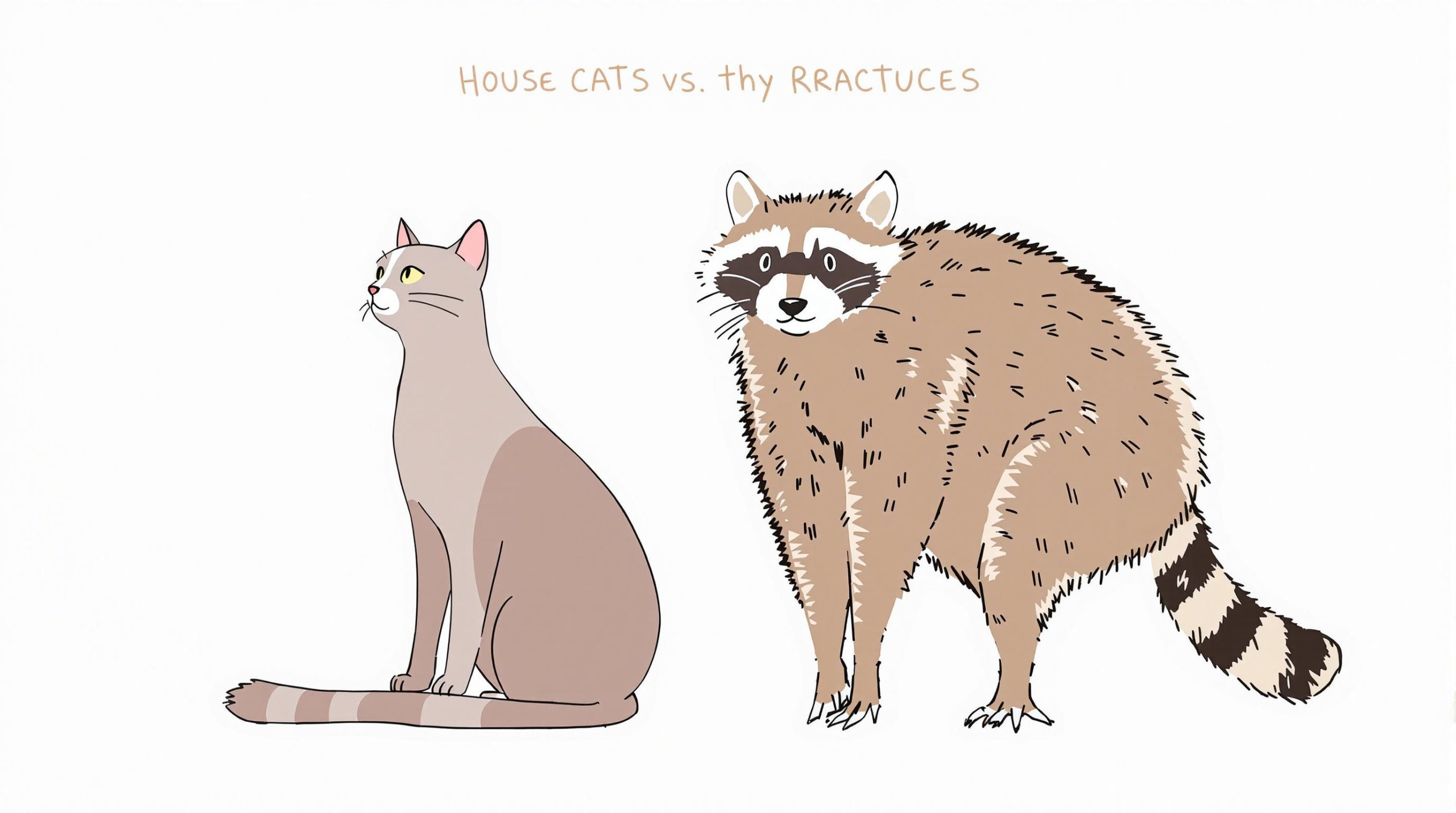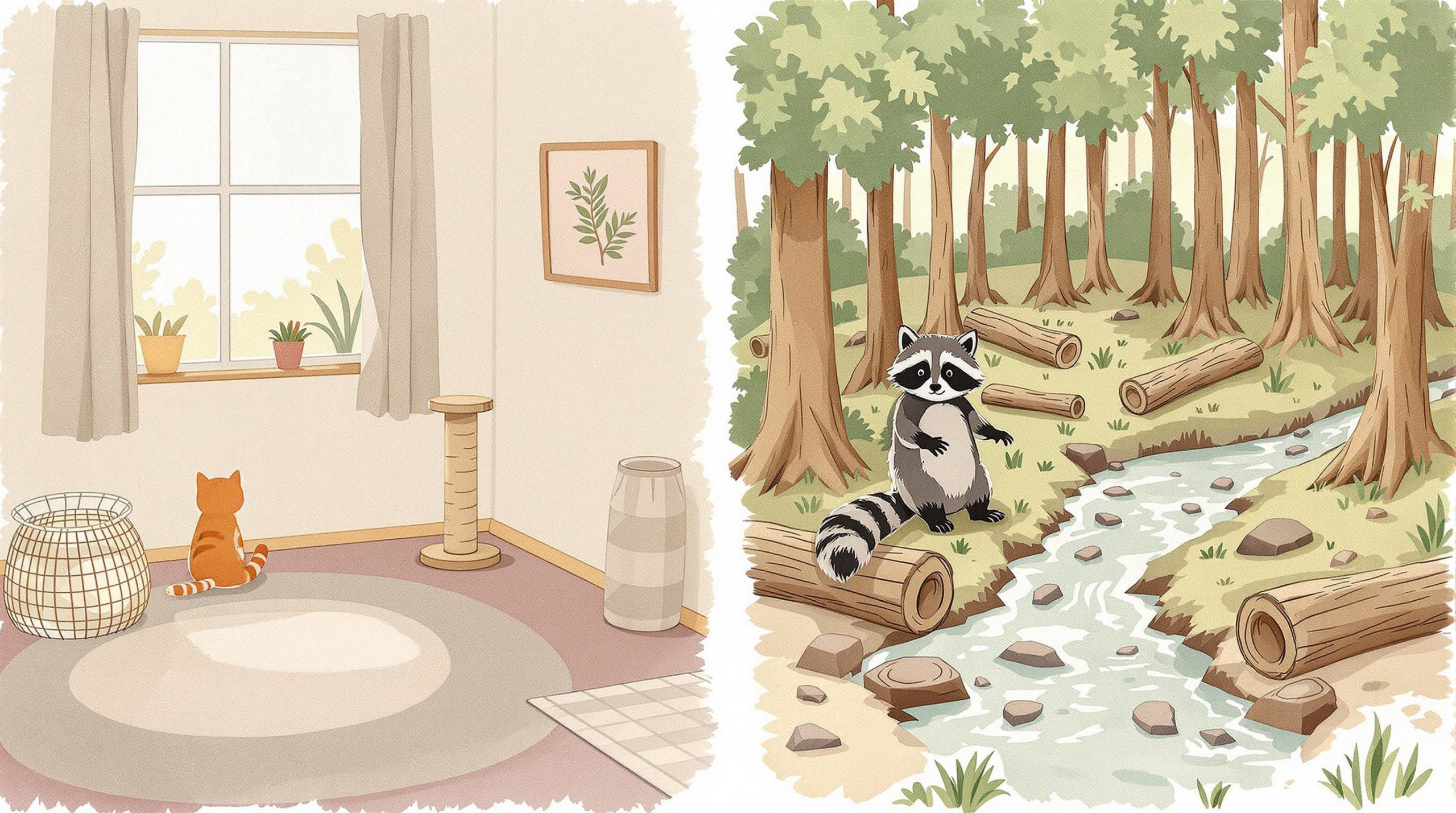Can cats and raccoons breed together?

In the realm of animal curiosities, the notion of a cat and raccoon pairing sparks vivid imaginations. Could these two seemingly similar yet distinct creatures create an enchanting hybrid? The fantasy of a “catcoon” with feline grace and raccoon charm captivates many, yet nature holds firm boundaries dictated by genetics and behavior. Cats and raccoons, though both members of the Carnivora order, diverge widely in family lineage, reproductive biology, and genetic compatibility. This divide firmly excludes any possibility of breeding between them, despite occasional encounters or myths told among animal enthusiasts. Delving into their biology, genetics, and ethology uncovers why such hybrids belong purely to the realm of speculation rather than reality, while enhancing our appreciation for the uniqueness of each species.
Exploring the Biological and Genetic Divides Preventing Cats and Raccoons from Breeding
At a glance, cats and raccoons share certain physical traits—both have sharp claws, pointed ears, and a similar body size that might lead to some confusion. However, beneath the surface lies a considerable genetic chasm. Domestic cats belong to the Felidae family, while raccoons are members of the Procyonidae family, representing two entirely separate evolutionary branches. This classification discrepancy indicates a significant genetic distance that renders interbreeding unfeasible.
One of the foremost barriers is their differing chromosome counts: cats possess 38 chromosomes, arranged in 19 pairs, whereas raccoons carry 42 chromosomes, constituting 21 pairs. This mismatch complicates the alignment of genetic material during reproduction, in turn preventing successful fertilization or viable offspring. Even in cases where chromosome numbers differ by only a few pairs, hybrid viability can be questionable. Between cats and raccoons, the difference is too substantial.
The reproductive mechanisms themselves present additional obstacles. Cats are induced ovulators, which means mating triggers ovulation. Conversely, raccoons are spontaneous ovulators with specific breeding seasons, whereas cats can mate year-round depending on environmental cues. The timing mismatch drastically reduces any chance for synchronized reproduction.
Behavioral differences make mating encounters unlikely as well. Cats tend to be more solitary and ritualistic in mating, while raccoons exhibit social mating behaviors often involving multiple partners during defined breeding periods. Such contrasting reproductive and social habits act as natural dissuaders for cross-species breeding.
Below is a quick comparison of essential biological factors between cats and raccoons:
| Characteristic | Domestic Cat (Felis catus) | Raccoon (Procyon lotor) |
|---|---|---|
| Family | Felidae | Procyonidae |
| Chromosome Count | 38 | 42 |
| Reproductive Type | Induced ovulator | Spontaneous ovulator |
| Breeding Season | Year-round | Seasonal |
| Social Behavior in Mating | Mostly solitary | Social and multiple partners |
Understanding these fundamental differences highlights why cats and raccoons cannot produce offspring together, regardless of superficial similarities or myths that might circulate.

Natural Behaviors and Habitat Differences Discouraging Any Mating Attempts Between Cats and Raccoons
Cats and raccoons occupy overlapping but distinct ecological niches, which impacts their interactions and likelihood of mating. While both adapt well to urban and suburban environments—leading to occasional encounters—these meetings rarely involve any reproductive behavior. Instead, they often revolve around competition for food resources or territory.
Domestic cats are natural hunters who prefer solitude. They patrol and defend established territories, marking them with scent glands and engaging in stealth to stalk prey like mice or birds. Their survival strategies and social habits differ greatly from those of raccoons, which are highly adaptable omnivores and opportunistic feeders. Raccoons thrive by scavenging in garbage bins, raiding bird feeders, and exploiting human waste resources. Their social behavior leans toward occasional group living, especially among females and juveniles, promoting a more communal lifestyle than cats.
Notably, raccoons are known for their washing behaviors—rubbing food in water before consumption—and their distinctive black ‘mask’ markings, which serve functions linked to social signaling and camouflage. Cats, by contrast, rely on more understated camouflage and have evolved keen night vision and silent movement, indicative of their predatory habits.
Such behavioral and ecological contrasts mean that even if a cat and raccoon crossed paths, their priorities and behavioral cues are unlikely to spark the complex mating rituals necessary for reproduction.
- Cats: Territorial, solitary hunters with specific mating cues.
- Raccoons: Social, resourceful scavengers with seasonal mating behaviors.
- Shared environments: Urban edges where food sources overlap but reproduction remains isolated.
This divide extends to diet and activity patterns, which, while somewhat overlapping as nocturnal creatures, differ markedly in food preference and foraging strategies.
| Trait | Cat | Raccoon |
|---|---|---|
| Diet | Carnivorous (primarily meat) | Omnivorous (plants, animals, garbage) |
| Activity Pattern | Nocturnal / crepuscular | Nocturnal |
| Habitats | Human homes, urban areas, forests | Forests, urban/suburban areas, wetlands |
| Social Structure | Mostly solitary | Loose social groups |
Despite these differences, cats and raccoons coexist in some spaces, sometimes even seeming to tolerate each other with peaceful interactions. This coexistence underscores behavioral adaptability but does not bridge reproductive incompatibility.

Why Genetic Incompatibility Makes Cat-Raccoon Hybrids an Impossible Reality
For hybridization to occur naturally, species usually must be closely related, sharing a recent common ancestor, similar chromosome numbers, and compatible reproductive systems. Classic hybrids like ligers (lion-tiger crosses) or mules (horse-donkey crosses) exist because of such genetic proximity despite being different species. In contrast, cats and raccoons diverged millions of years ago, belonging to entirely different families within Carnivora, making genetic compatibility highly improbable.
The disparity in chromosome numbers—38 in cats versus 42 in raccoons—prevents stable chromosomal pairing during meiosis, the cell division process creating sperm and egg cells. Without proper pairing, fertilization fails or produces non-viable embryos. Even if fertilization occurred, the genetic mismatch would typically result in sterile offspring or developmental abnormalities.
Scientifically documented hybrids are scarce and typically limited to species within the same genus. There are no verified cases of cat-raccoon hybrids. Reports or images circulating online symbolizing “catcoon” or “racat” tend to be misunderstandings, natural mutations, or cross-breed variations within cat species, such as the polydactyl Maine Coon—famously known for its larger size and distinctive appearance. These cats have been extensively studied, including their origins detailed on mainecoonlife.com.
The fascination with the theoretical cat-raccoon hybrid also stems from cats sporting facial markings somewhat resembling raccoons’ masks. However, these are purely superficial and genetic unrelated traits.
| Criteria for Successful Hybridization | Cat and Raccoon Compatibility |
|---|---|
| Same Family | No (Felidae vs Procyonidae) |
| Chromosome Number Match | No (38 vs 42 chromosomes) |
| Similar Reproductive Cycle | No (induced vs spontaneous ovulation) |
| Behavioral Mating Compatibility | No (solitary vs social) |
Modern genetic testing continues to reinforce the clear distinctions between these animals, supporting the conclusion that any breeding attempts would be biologically futile.
Ethical and Legal Concerns in the Context of Attempting Cat-Raccoon Breeding
Given the impossibility from biological and genetic standpoints, any attempt to breed cats with raccoons would raise significant ethical and legal concerns. Animal welfare organizations like the ASPCA and many wildlife authorities enforce strict regulations against cross-species breeding, especially between wild and domestic animals.
The distinct needs, diets, and behavioral traits of cats and raccoons mean that forcing such hybrids would likely entail suffering from health complications, psychological stress, and behavioral issues. Additionally, domestic cats vaccinated and cared for with specialized diets—such as those offered by PetSmart, Chewy, Hill’s Science Diet, Royal Canin, Purina, Meow Mix, and Friskies—are vastly different in environmental requirements compared to raccoons, which are wild and omnivorous.
Moreover, introducing a hypothetical hybrid could disrupt natural ecosystems, posing risks of disease transmission among wildlife and pets. For example, raccoons can carry parasites and diseases dangerous to cats, highlighting the importance of keeping these species properly separated.
Legal regulation across many countries prohibits creating hybrids that do not occur naturally. Such laws exist to:
- Protect animal welfare from possible cruelty and neglect.
- Avoid ecological imbalances stemming from unnatural species crossings.
- Prevent the spread of zoonotic diseases between wildlife and domestic animals.
Ethical pet ownership encourages respect for natural species barriers. For instance, Maine Coon enthusiasts on mainecoonlife.com emphasize maintaining breed purity and avoiding irresponsible hybridization attempts.
These principles align with the missions of animal-focused retailers and organizations such as Petco and Wildlife Republic, underscoring education and welfare over novelty.
The Fascinating Appeal and Differences of Cats and Raccoons in Urban and Natural Environments
While crossbreeding between cats and raccoons remains biologically impossible, their coexistence in various environments continues to intrigue observers. Urban wildlife enthusiasts often witness these animals occupying similar niches and sometimes even tolerating each other’s presence.
Cats, especially breeds like the Maine Coon, enjoy popularity for their majestic appearance and gentle dispositions. Their care involves quality nutrition and well-rounded environments, supported by products and advice from companies such as Catit, Royal Canin, and Hill’s Science Diet. Their average lifespan and price points are well-documented, with expert resources on mainecoonlife.com and mainecoonlife.com.
Raccoons, clever and adaptable, add urban wildlife charm but come with their own challenges. Their nocturnal habits and determination sometimes position them as competitors with cats for food, especially near bird feeders or unsecured trash cans. This creates an interesting dynamic where both species exist side-by-side, highlighting the diversity of urban fauna.
- Cats: Valued as pets, they provide companionship and pest control but need responsible care and genetic stewardship.
- Raccoons: Wild, intelligent, and resilient survivors, raccoons symbolize nature’s ability to adapt to human environments.
- Human Role: Educate about coexistence, avoid feeding wildlife to reduce conflicts, and maintain secure habitats.
Recognizing these differences allows for better cohabitation principles, promoting animal welfare without entertaining unrealistic breeding projects.
FAQ on Cat and Raccoon Breeding Compatibility
- Can cats and raccoons naturally interbreed?
No, their genetic and reproductive differences prevent them from producing offspring. - Have any cat-raccoon hybrids ever been documented?
There are no confirmed cases of hybrid offspring between cats and raccoons. - Why do cats sometimes resemble raccoons in appearance?
Some cats have facial markings or features similar to raccoons, but these are natural variations within cat breeds, such as the polydactyl Maine Coon. - Is it ethical to try to breed cats and raccoons?
No, ethical guidelines and animal welfare laws strongly discourage and often prohibit attempts to crossbreed such genetically incompatible species. - Where can I learn more about fascinating cat breeds like the Maine Coon?
Comprehensive resources are available on mainecoonlife.com, detailing their history, care, and breed characteristics.